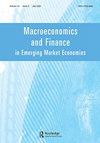Monetary policy transmission in India: new evidence from firm-bank matched data
IF 1.1
Q3 ECONOMICS
Macroeconomics and Finance in Emerging Market Economies
Pub Date : 2022-04-27
DOI:10.1080/17520843.2022.2067682
引用次数: 0
Abstract
ABSTRACT
This paper uses a unique firm-bank matched data set for India to provide new insights into the monetary policy transmission mechanism. Our assessment of the bank-lending channel suggests that an increase in credit may have a heterogeneous effect on firms based on the liquidity positions of the lending banks. Investment in fixed assets is found to increase for firms that borrow from liquid banks, when these banks increase their lending. By contrast, we find increased financing of current liabilities – and not increase in long-term investment – for firms that borrow from the less liquid banks.
印度的货币政策传导:来自企业-银行匹配数据的新证据
摘要本文利用印度独特的企业-银行匹配数据集,为货币政策传导机制提供了新的视角。我们对银行贷款渠道的评估表明,根据贷款银行的流动性状况,信贷的增加可能对企业产生异质影响。研究发现,当流动性银行增加贷款时,从流动性银行借款的企业的固定资产投资会增加。相比之下,我们发现,从流动性较差的银行借款的公司,流动负债融资增加,而长期投资没有增加。
本文章由计算机程序翻译,如有差异,请以英文原文为准。
求助全文
约1分钟内获得全文
求助全文
来源期刊
CiteScore
2.40
自引率
7.70%
发文量
23

 求助内容:
求助内容: 应助结果提醒方式:
应助结果提醒方式:


